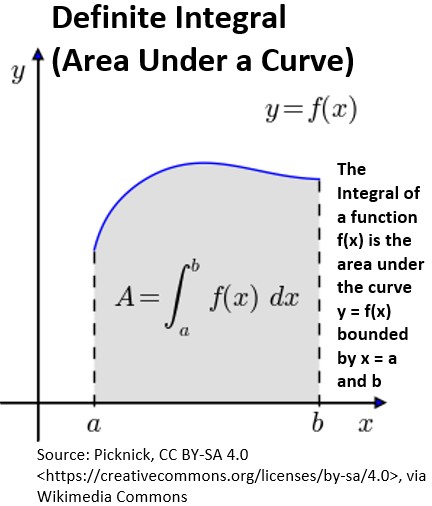Menu (linked Index)
Integration Rules
Last Update: July 1, 2025
Introduction
Finding the area under a curve in physics is very useful.
For example, the work done on an object that is displaced a distance d is computed as W = force x distance.
This can be plotted to produce a graph perhaps similar to the one shown below in the next section.
The area under the force curve would then represent the work.
The process of computing this area is called integration.
In this post I introduce the definition of an integral and provide some of the basic math involved in taking integrals.
The Concept of Integration
Integration is the process of finding the total or accumulation of a quantity.
An integral is the mathematical result of this process, representing either:
- The antiderivative: A function whose derivative is the original function (indefinite integral, often written as ∫f(x)dx).
- The net area under a curve: The total value accumulated between specific points a and b (definite integral, written as ∫ab f(x)dx )

Integration is essentially the reverse process of differentiation.
Notation
Indefinite Integral (Antiderivative): ∫f(x) dx=F(x)+C
- ∫: The integral symbol.
- f(x): The integrand (the function you want to integrate).
- dx: The differential, indicating that you’re integrating with respect to the variable x.
- F(x): The antiderivative of f(x) (meaning F′(x)=f(x)).
- C: The constant of integration.
- The derivative of any constant is zero, so when you reverse the process, you don’t know what constant was there originally.
Definite Integral (Area Under a Curve): ∫ab f(x)dx = F(b)−F(a)
- a: The lower limit of integration.
- b: The upper limit of integration.
- This calculates the net area between the curve f(x) and the x-axis from x=a to x=b.
Basic Integration Formulas (Rules for Antiderivatives)
These are the fundamental “formulas” you’ll use most often.
For a definite integral (integrating within an upper and lower limit), the C in the formulas below disappear because they cancel out.
Power Rule (for n ≠−1)
- ∫xndx = x(n+1)/(n+1) + C
- Example:∫x3dx = x(3+1)/(3+1) + C = x4/4 + C
- Example:∫1dx = ∫x0dx = x1/1 = x
Power Rule (for n=−1)
- ∫1/xdx =∫x-1 dx= ln∣x∣ + C
- ∣x∣ = absolute value of x
- Example: ∫1/t dt=ln∣t∣ + C
Constant Multiple Rule
- ∫cf(x) dx = c∫f(x) dx
- Example: ∫5x2 dx = 5∫x2 dx = 5(x3/3) + C = 5/3x3 + C
Sum/Difference Rule
- ∫[f(x)±g(x)] dx=∫f(x) dx ± ∫g(x) dx
- Example: ∫(x2−3x+1) dx=∫x2 dx − ∫3x dx+∫1 dx=x3/3 − 3x2/2 + x + C
Integral of a Constant
- ∫c dx = cx+C
- Example: ∫7 dx = 7x + C
Trigonometric Integrals
- ∫cos(x) dx = sin(x) + C
- ∫sin(x) dx = −cos(x) + C
- ∫sec2(x) dx = tan(x) + C
- ∫csc2(x) dx = −cot(x) + C
- ∫sec(x)tan(x) dx = sec(x) + C
- ∫csc(x)cot(x) dx = −csc(x) + C
Exponential Integrals
- ∫ex dx = ex + C
- ∫ax dx = ax /ln a + C (for a>0 , a≠1)
Integration Techniques Beyond Basic Formulas
When the function isn’t a simple form, various techniques can be used to find a solution.
For a particular problem, you can mostly likely find the complete solution by asking your preferred AI app (like Google Gemini for example).
I will list examples here when relevant to other blogs I have written:
Example 1: Take the integral of (V/L)sin(ωt)dt
∫(V/L)sin(ωt)dt
Pull out the constants
(V/L)∫sin(ωt)dt
Integrate sin(ωt) using substitution technique
This requires a u-substitution, where
- u = ωt and
- du = ωdt , so
- dt = 1/ω du.
(V/L)(1/ω)∫sin(u)du
From the trig integrals we know that ∫sin(u) = -cos(u) so
(V/L)(1/ω)(-cos(u)) + Constant
Rearrange and substitute ωt for u
∫(V/L)sin(ωt)dt = -V/(Lω)(cos(ωt) + C
The term ω is typically the angular frequency in physics and engineering contexts (like AC circuits), while V/L is often a constant related to voltage and inductance.
Example 2: Placeholder
Example 3: Placeholder
Disclaimer: The content of this article is intended for general informational and recreational purposes only and is not a substitute for professional “advice”. We are not responsible for your decisions and actions. Refer to our Disclaimer Page.
